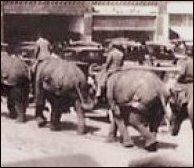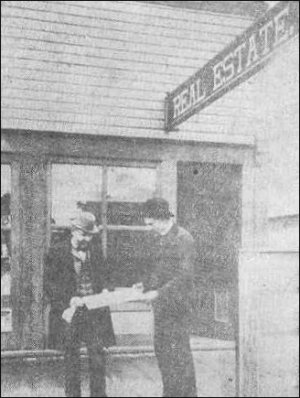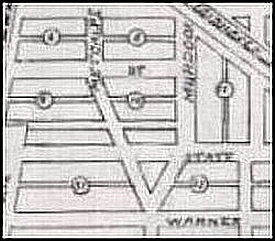 | Click for full-size photo
|
This photo on the upper right (click for full size) is of the parade of elephants from the Al Barnes Circus on May 15, 1922, just before one of them, Tusko, tore up the town of Sedro-Woolley The photographer was looking northwest from about where the Old Timers Tavern now stands on the south side of State Street. The brick building at the left is the combined Livermore apartments (upstairs) and retail space and Skagit Realty (lower floor) at the northwest corner of State and Metcalf streets. That is the wide end of the Kelley Strip, which is explained in the article above. In the center, behind and to the left of the elephants, is a row of billboards along the sidewalk of the north side of State Street, a continuation of the Kelley Strip.
 | See below
|
In the mid-1890s, the south end of that long block between Metcalf and Murdock streets (later the 800 block), and facing south on State Street, was called the Bowery or Bowery Square. The only permanent structure erected there was an open-sided community building that was originally called the Bowery Hall. Apparently in the beginning it was open on all sides with a tent top. By 1898 that was replaced by a wooden structure called the Opera House, which in turn became the Moose Lodge two decades later and still later it was a roller rink, Danceland and finally a cafe before it was torn down in about 1972. The space behind the billboards in this photo stayed empty until 1923 when the Masonic Lodge erected a one-story building with a mezzanine that initially housed the Ludwick-Wuest Department Store. It later housed the J.C. Penney store, starting in 1938 and, after a brief vacancy, it has been the home of Bus Jungquist Furniture since 1983.
This photo at the left shows a meeting between Junius Brutus Alexander (left) and Harry L. Devin, principals of the Sedro Land Co. SLC was an outgrowth of Norman R. Kelley's Sedro Land & Improvement Co. (SLIC), which platted and sold the lots of new-Sedro. The office at that time, circa 1900, was on the south side of State Street, about where the Old Timer's Tavern stands in 2007.
Soon after the turn of the 20th Century, SLC was based in the Woolley part of town, in the 800 block of Metcalf where R&E Engineery stands in 2007, but with the same leaders and stockholders. Devin and Charles J. Wicker were partners in Skagit Realty, which they began in 1902 and which was the longest surviving realty company in the county when it closed in 1998. Alexander, the SLC president, moved here from Brooklyn in 1890 after graduating from Harvard College. Wicker and Devin came from Iowa, in 1884 and 1890, respectively.
Skagit Realty and SLIC/SLC sold, re-sold and promoted almost every property, both town lots and acreage, in Sedro-Woolley and upriver during the early years. Prospective buyers and sellers checked in at the Skagit Realty to learn about plats, developments and the real estate market. The location of the building in the photo was identified in the source newspaper as Ferry Street, but we have researched and discovered that the Skagit Realty buildings were always on Metcalf. This was probably taken on the east side of Metcalf sometime before 1912. Photo courtesy of Sedro-Woolley Courier-Times 1953 Territorial Centennial edition.
|

 810 Central Ave.,
810 Central Ave., 


